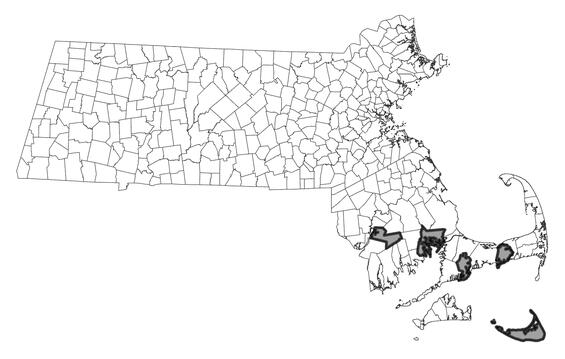- Scientific name: Dichanthelium mattamuskeetense
- Species of Greatest Conservation Need (MA State Wildlife Action Plan)
- Endangered (MA Endangered Species Act)
Description
This perennial grass species belongs to a distinct subgroup of the large and complex rosette-grass genus that is distinguished by different spring and fall growth habits known as the vernal and autumnal phases. The vernal stems (culms in grasses) are smooth, olive-green, and purple-tinged, standing 30-75 cm (12-30 in) high. The purplish leaves are up to 12 mm (0.5 in) wide and 12 cm (~5 in) long, slightly rounded at their base, usually hairless and spread out from the culm. The nodes (thickened or hardened joints found on all grasses) are usually densely bearded with grayish hairs. The vernal flower panicle is carried high above the leaves on a long stalk, is usually single, relatively large, well-branched, bearing many one-flowered spikelets about 2.3 mm (0.09 in) long, elliptic and with minute hairs. These spikelets, which appear in early summer, form straw-colored fruit without any seed.
In the autumnal phase, the plant is less erect, often leaning or reclining. Branching of the stem also occurs at the middle to upper nodes. The flower panicles are smaller but more numerous, emerging from the bases of the reduced fall leaves. These spikelets are self-fertile and produce seed. An overwintering basal rosette of short leaves is produced.
Forked rosette-grass (Dichanthelium dichotomum) is a widespread species that resembles Mattamuskeet rosette-grass in several characters. However, it has hairless spikelets which average about 2mm (0.08 in) long. It is usually a smaller plant with narrower leaves (3-8 mm [0.12-0.31 in]), not often tinged purple, and the panicle is usually short-stalked. Autumn plants are very “bunchy” looking, due to the numerous, close-set leaves. It usually occurs in drier, often wooded habitats, or in the open at disturbed sites.
Life cycle and behavior
This is a perennial grass.
Population status
Mattamuskeet rosette-grass is listed as an endangered species in Massachusetts in part because of its increasing rarity towards the periphery of its range. Little historical documentation is available to determine if this species is in decline or stable. Possibly it has been overlooked or gone unrecognized as distinct from its close relatives. Its preference for certain disturbed sites may be tied to the present scarcity of available primary habitat. In the past, open boggy ground and moors were more prevalent than today. Subsequent habitat succession has led to reforestation and shrubby overgrowth of these sites. The MassWildlife’s Natural Heritage & Endangered Species Program database has 14 records from 6 counties: Barnstable, Bristol, Dukes, Nantucket, Middlesex, and Plymouth. Seven of these records have been observed within the last 25 years.

Distribution in Massachusetts
1999-2024
Based on records in the Natural Heritage Database
Distribution and abundance
Mattamuskeet rosette-grass is distributed on the Atlantic coastal plain from southeastern Massachusetts to South Carolina, extending inland to the lower Piedmont and disjunct in Indiana.
Habitat
This species is found in seasonally wet, sunny habitats that are often created through some form of human disturbance or intervention. These include trails, powerlines, roadsides and ditches which have been opened up in or near a swamp, marsh, or streambed. The exposed, damp to wet soils are predominantly sandy, but often covered with a thin peaty or organic layer that indicates an originally bog-like habitat. One site for this rosette-grass is a former shrub swamp now opened completely by annual mowing where thousands of plants of Mattamuskeet rosette-grass are co-dominant with thread-leaved sundew (Drosera filiformis), white fringed orchis (Platanthera blephariglottis), and sheep-laurel (Kalmia angustifolia) in the wet sphagnous depressions.
At other sites, the associated species vary, depending on the nature of the original habitat. It is not unusual for species from more than one type of plant community to be present, as this is a common outcome in disturbed habitats. They include species indicative of boggy swamps and thickets: inkberry (Ilex glabra), swamp azalea (Rhododendron viscosum), spatulate sundew (Drosera intermedia), wild raisin (Viburnum cassinoides); of sandplains and pine barrens: huckleberry (Gaylussacia baccata), colicroot (Aletris farinosa), broomsedges (Andropogon virginicus); and of coastal pondshores: slender-leaved goldenrod (Euthamia caroliniana), Plymouth gentian (Sabatia kennedyana), meadow-beauty (Rhexia virginica).
Healthy habitats are vital for supporting native wildlife and plants. Explore habitats and learn about conservation and restoration in Massachusetts.
Contact
| Date published: | April 14, 2025 |
|---|